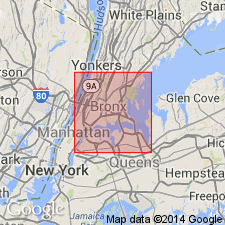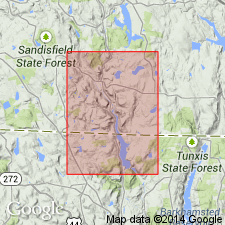
- Usage in publication:
-
- Manhattan Schist*
- Modifications:
-
- Revised
- Age modified
- Geochronologic dating
- AAPG geologic province:
-
- New England province
Summary:
Manhattan Schist member A replaced by Walloomsac Formation (not new) based on work by Jackson and Hall (1982), Hall (in press), and A.A. Drake (1990, pers. commun.). In addition, L.M. Hall (1985?, pers. commun.) determined that member B of the Manhattan Schist is part of member C and thus recommended the abandonment of member B. Mose and Hall (1979) determined that the Manhattan Schist is of Early Cambrian age on the basis of a rubidium-strontium whole-rock isochron of 555+/-21 Ma.
Source: GNU records (USGS DDS-6; Reston GNULEX).

- Usage in publication:
-
- Manhattan Schist
- Modifications:
-
- Overview
- AAPG geologic province:
-
- New England province
Summary:
Cambrian Manhattan Schist in this report includes four informal members: Warren member, garnetiferous biotite schist member, Shepaug member, and schistose granulite member. The Warren member occurs only in the Above All thrust sheet, the Shepaug member only in the Rabbit Hill thrust sheet. The schist member occurs in both. The granulite member occurs in the Rabbit Hill thrust sheet and the Lake Waramaug thrust sheet. The Warren includes mainly interbedded, dark-gray, muscovite-garnet-chlorite-plagioclase-biotite-quartz schist, amphibolite lenses, siliceous granulite, and finely-layered schistose gneiss. The Shepaug consists of interbedded orthoclase-garnet-plagioclase-biotite-quartz schistose gneiss, rusty-weathering, schistose gneisses and schists with sillimanite rods, and subordinate granulite beds with sillimanite nodules similar to those in the schistose granulite member.
Source: GNU records (USGS DDS-6; Reston GNULEX).
For more information, please contact Nancy Stamm, Geologic Names Committee Secretary.
Asterisk (*) indicates published by U.S. Geological Survey authors.
"No current usage" (†) implies that a name has been abandoned or has fallen into disuse. Former usage and, if known, replacement name given in parentheses ( ).
Slash (/) indicates name conflicts with nomenclatural guidelines (CSN, 1933; ACSN, 1961, 1970; NACSN, 1983, 2005, 2021). May be explained within brackets ([ ]).

